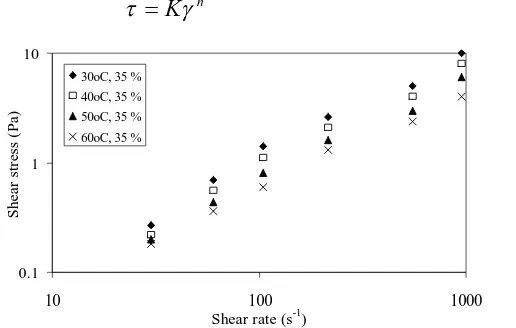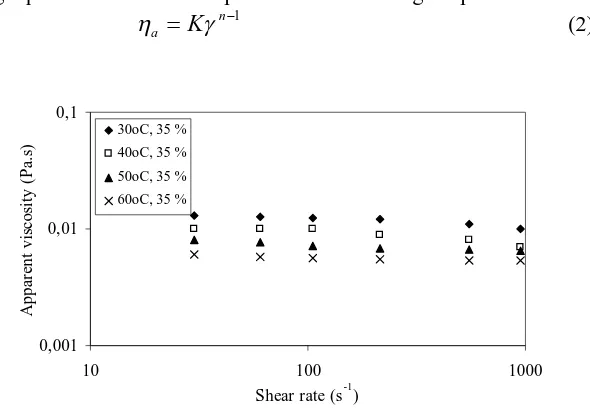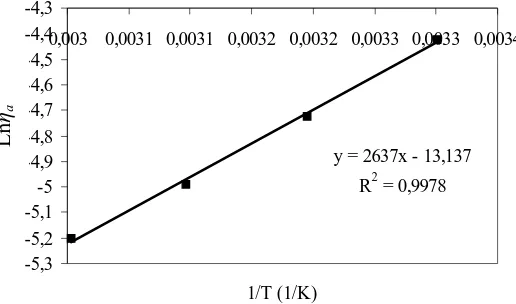Edited by Daud et al.
MODELING ON RHEOLOGICAL PROPERTIES OF
TROPICAL FRUIT JUICES
Diah Susetyo Retnowati, Andri Cahyo Kumoro and Ch. Sri Budiati Department of Chemical Engineering, Faculty of Enginering
Diponegoro University
Prof. H. Soedarto, SH Road Tembalang-Semarang-INDONESIA 50239. Tel.: +62-24-7460058, Fax: +62-24-76480675, Email: [email protected]
Keywords: concentration; noni; shear rate; temperature; viscosity; water extract
ABSTRACT
Fruit juice industry is one of the world’s biggest agribusinesses. During processing, it deals with juice in a variety of concentrations and temperatures. In order to have a suitable process design, operation and control, knowledge of rheological behaviour of the fruit juice is of fundamental importance. The aim of this work was to measure the viscosity and density of fruit juice as a function of temperature and juice concentration and to obtain simple equations to correlate experimental data. The flow properties of water extract of Noni fruit were determined using a concentric cylinders rotational viscometer for extract concentration of 35 and 65% TS, temperature range of 30-60°C and shear rate range of 2.5-950 s-1. The measured shear stress was within 0.5 to 50 Pa, corresponding to viscosity range of 0.0015-1.6 Pa.s. Within the tested conditions, the extract exhibited a pseudo plastic behaviour. The experimental results were well fitted by power law models.
INTRODUCTION
interest in quality control, consumer acceptability, and engineering calculations related to the processing and handling of FF. With regard to these engineering calculations, knowledge of the applicable flow models is important for design of flow systems (Rao and Anantheswaran, 1982). The effect of temperature and concentration on apparent viscosity must be well understood for the operation of heat transfer and evaporation of FF (Rao et al.1984; Vitali and Rao, 1982).
Published work on the behaviour of Noni extract is apparently scarce. Such studies, however, help in the understanding of unit operations related to noni extracts, and are thus of practical importance. The objective of this work was, therefore, to determine the type of flow behaviour of Noni extract, to study the effect of temperature and concentration on the flow behaviour, and to fit popular flow models that are useful in design of relevant equipment and processes.
MATERIALS AND METHODS
Materials
Juices of noni (Morinda citrifolia L) fruit were prepared by juicing noni fruit pulp using Green Power Juice Extractor (Model GPE1503 Gold). Part of the extract was concentrated under vacuum using a pilot scale falling film evaporator (Luwa thin film evaporator, pilot plant LN 0012, SMS, GmbH, Germany). The resulting concentrate was of total solids (TS) of 65%. Different extract concentrations were prepared by mixing pre-calculated amounts of water and the concentrated (65% TS) extract. The final extract concentrations were 5, 15, 25, 35, 45, 55 and 65% TS. All concentrations were filled into clean sterilized 1.5 L glass jars and stored at 4°C prior to viscometric measurements.
Methods
A concentric cylinder rotational viscometer Brookfield rheometer (Model DV- 111) was used to determine the viscosity and shear rate of juice. The viscometer was connected to both a heating bath circulator and a frequency converter to make up an integrated system. It allows the continuous measurements of the shear stress, shear rate data at different temperatures. Sensor system NV was used for low and intermediate viscosity samples (5, 15, 25 and 35% TS) and sensor systems MVI and MVII for the others (45, 55 and 65% TS). Flow data were obtained over the temperature range 30-60°C. The temperatures of the samples were kept constant by circulating water at the desired temperature, using the heat bath circulator, around the reservoir containing the sample.
order to obtain several soluble solids concentrations for each experiment. The density of the fruit juice was determined using a pycnometer for temperatures from 30 to 60°C. The pycnometer had previously been calibrated with distilled water in a heating process, where the sample pycnometer was weighed at 5°C intervals from 30 to 60°C. The temperature was controlled by a thermostatic water bath (Digiterm 3000613, Selecta, Spain).
RESULTS AND DISCUSSIONS
Typical flow curves obtained for representative noni extract concentrations at different temperatures are shown in Figure 1 and 2. The simple power law model described well the shear rate-shear stress data:
n
K
(1)FIGURE 1. Shear Stress As Function Of Shear Rate And Temperature for The 35% (TS) Extract
and the magnitude of the power law parameters are within 0.8050-0.9715. Values of the flow behaviour index (n) were consistently below unity indicating a shear-thinning (pseudo plastic) behaviour of the noni extract at all concentrations and temperatures tested. No consistent trend of the flow behaviour index as affected by concentration and temperature was evident. However, the consistency index (K) decreased with increasing temperature and decreasing concentration, with the values were between 0.0071-0.9500.
Experimental apparent viscosity (ηa) as a function of shear rate and temperature
for extract having 35% solid concentrations is plotted as shown in Figure 3. The following equation was used to fit prediction lines through experimental data:
1
n
a K
(2)FIGURE 3. Apparent Viscosity As Function Of Shear Rate And Temperature for The 35% (TS) Extract
The viscosity of a solution is a function of the intermolecular forces and water-solute interactions that restrict the molecular motion. These forces are affected by changes in both concentration and temperature. When a solution is heated, the viscosity decrease since thermal energy of the molecules increases and the intermolecular distances increase due to thermal expansion (Constenla et al., 1989). The Arrhenius relationship equation (3) has been extensively used to describe the effect of temperature on the apparent viscosity (ηa) at a specified
shear rate (Wang & Meisen, 1994):
2.0516 × 10-6 (Pa.s), respectively. It must be mentioned that the tested temperature range, were 30-60°C for 35% TS concentration. The results are plotted in Figure 4 as the logarithm of apparent viscosity versus the reciprocal of absolute temperature. The linearity of the curves indicates good accordance with equation (3).
FIGURE 4. Ln ηa As A Function Of 1/T (K -1
) For 35% Solid Concentrations At Shear Rate Of 205 (s-1).
CONCLUSIONS
The shear stress values of the fruit juice at a given shear rate were found higher for higher solid concentration. Temperature has inverse effect on shear stress and apparent viscosity. The noni fruit juice showed its pseudo plastic flow behaviour. The Arrhenius model approach was adequate to represent the effect of temperature on fruit juice viscosity.
NOTATION
E = Activation energy of flow (kJ/kmol)
K = Consistency index (Pa. sn)
n = Flow behaviour index (dimensionless)
R = The gas constant (8.314 kJ/kmol K)
T = Absolute temperature (K)
y = 2637x - 13,137
0,003 0,0031 0,0031 0,0032 0,0032 0,0033 0,0033 0,0034
= Shear stress (Pa) γ = Shear rate (s-l)
ηα = Constant parameters (Pa. s)
ηa = Apparent viscosity (Pa. s)
ACKNOWLEGDEMENT
The authors would like to express their gratitude to Diponegoro University for the financial support of this research project through the Faculty of Engineering Cluster Research Grant 2008.
REFERENCES
Constenla. D. T. Lozano. J. E. & Crapiste, G.H. (1989). Thermophysical properties of clarified apple juice as a function of concentration and temperature. J. Food Sci.. 54(3), 663-668.
Rao, M. A. & Anantheswaran, R. C. (1982). Rheology of fluid in food processing. Food Technol., 36(2), II6- 126
Rao, M. A. Cooly, H. J. & Vitali. A. A. (1984). Flow properties of concentrated juices at low temperatures. Food Technol., 38(3), 1 l3- I 19.
Vitali, A. A. & Rao, M. A. (1982). Flow behaviour of guava puree as a function of temperature and concentration. J. Texture Studies, 13, 275-289.
Wang, F. & Meisen, A. (1994). Flow properties of canola seed pastes. J. Food


